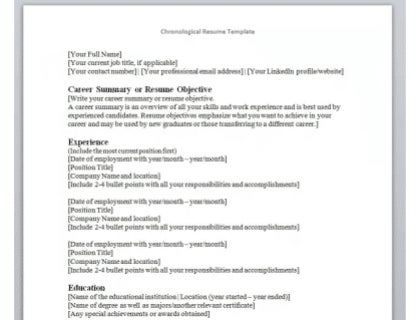
Download our Chronological Resume Template:
Start applying for jobs today using our chronological resume template.
Download NowChronological Resume Template: (Text Version)
[Your Full Name] [Your current job title, if applicable] [Your contact number] | [Your professional email address] | [Your LinkedIn profile/website]
Career Summary or Resume Objective [Write your career summary or resume objective. A career summary is an overview of all your skills and work experience and is best used by experienced candidates. Resume objectives emphasize what you want to achieve in your career and may be used by new graduates or those transferring to a different career.]
Experience (Include the most current position first) [Date of employment with year/month – year/month] [Position Title] [Company Name and location] [Include 2-4 bullet points with all your responsibilities and accomplishments]
[Date of employment with year/month – year/month] [Position Title] [Company Name and location] Include 2-4 bullet points with all your responsibilities and accomplishments]
[Date of employment with year/month – year/month] [Position Title] [Company Name and location] [Include 2-4 bullet points with all your responsibilities and accomplishments]
Education [Name of the educational institution | Location (year started – year ended)] [Name of degree as well as majors/another relevant certificate] [Any special achievements or awards obtained]
[Name of the educational institution | Location (year started – year ended)] [Name of degree as well as majors/another relevant certificate] [Any special achievements or awards obtained]
[Name of the educational institution | Location (year started – year ended)] [Name of degree as well as majors/another relevant certificate] [Any special achievements or awards obtained]
Skills [Bulleted list of all your key skills, relevant to the position you are applying for. Limit the list to between 5 and 10 skills. Include both hard skills (skills that can be learned and measured) and soft skills (individual characteristics that are learned through experience and interaction with others)].
How to Write a Chronological Resume:

Irrespective of the type of resume you write, there are some basic guidelines you'll have to follow. Read through our step-by-step guide to find out how to construct each section of your resume and to make a great impression on the hiring manager.
Create your chronological resume.
List your name and contact details at the top of the resume.

Always use a professional email address and a reliable contact number, and include your LinkedIn profile or any links to websites relevant to your work.
Add a career summary.

Include a Career Summary or Resume Objective beneath your contact details. A career summary statement would be better suited to a chronological resume.
List the three most relevant jobs for the post you are applying to.

Start with your current or most recent position. Include the period you have held each position, your job title, the company's name, and location, as well as 2-4 bullet points describing your key duties and any achievements. Only include jobs you've had in the last 15 years.
List your qualifications.

Start with the most recently obtained qualifications. Include any degrees, diplomas, or certificates that are relevant to the position you are applying for.
Include your skills.

List both hard and soft skills, limiting the section to between five and ten points.
Chronological vs. Functional Resume:
A chronological resume is primarily focused on work experience and lists the jobs you've held in reverse-chronological order. A functional resume will prioritize the skills and education of the candidate, listing these sections at the top, with work experience relegated to the bottom of the resume.
More Resources:
- Google Docs Resume Template.
- 50 Tips for Writing a Great Resume.
- Best Fonts for Resumes.
- Skills to Put on a Resume.
- How to Write a Targeted Resume.
- How to Write a Combination Resume.
Resumes by Profession:
- Android Developer Resume.
- Apartment Manager Resume.
- Babysitter Resume.
- Banquet Server Resume.
- Copywriter Resume.
- 3D Artist Resume.
- Data Analyst Resume.
- Engineering Resume.
- HR Administrator Resume.
- Interior Designer Resume.
- IT Help Desk Resume.
- Loss Prevention Officer Resume.
- Math Teacher Resume.
- Medical Biller Resume.

